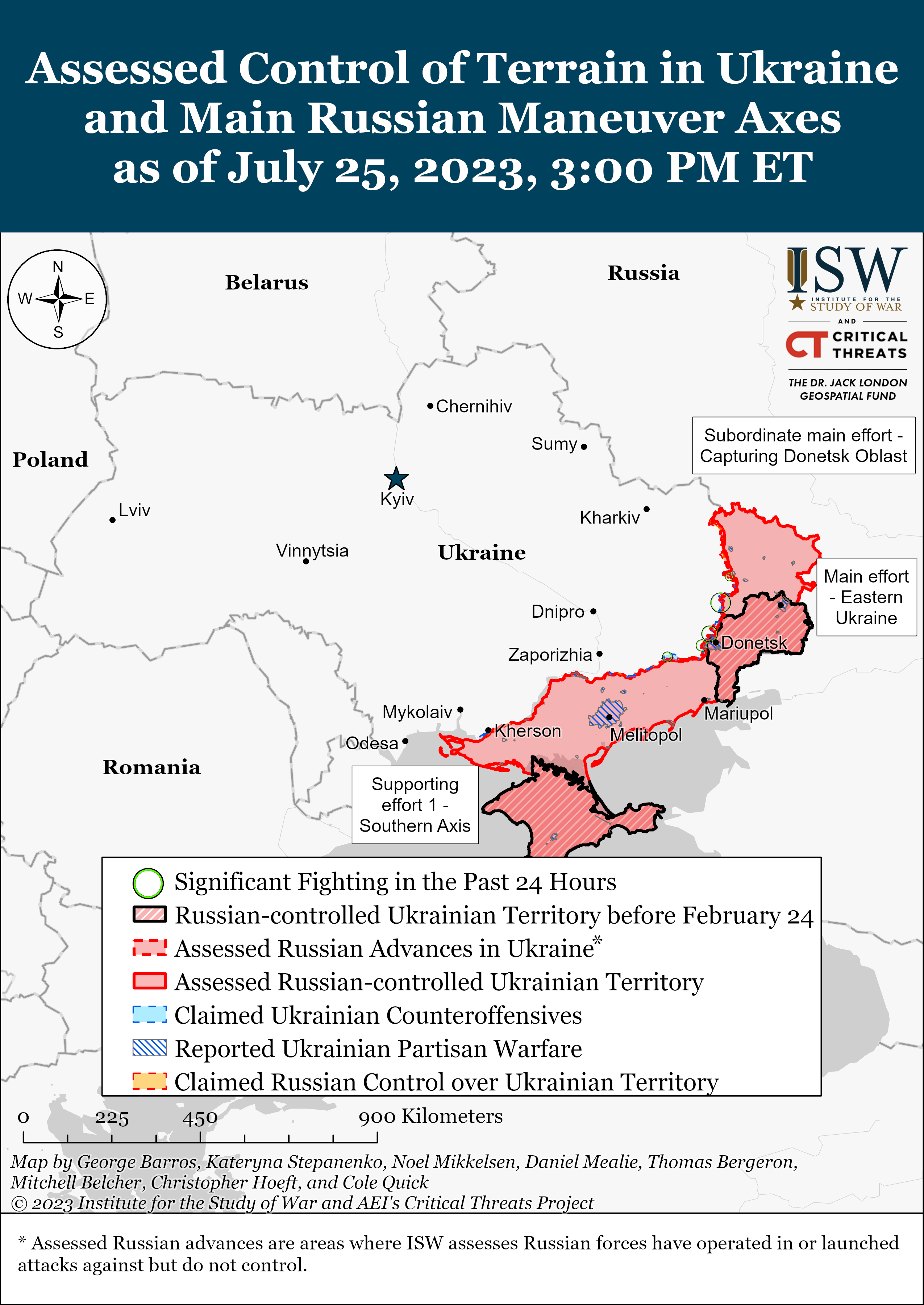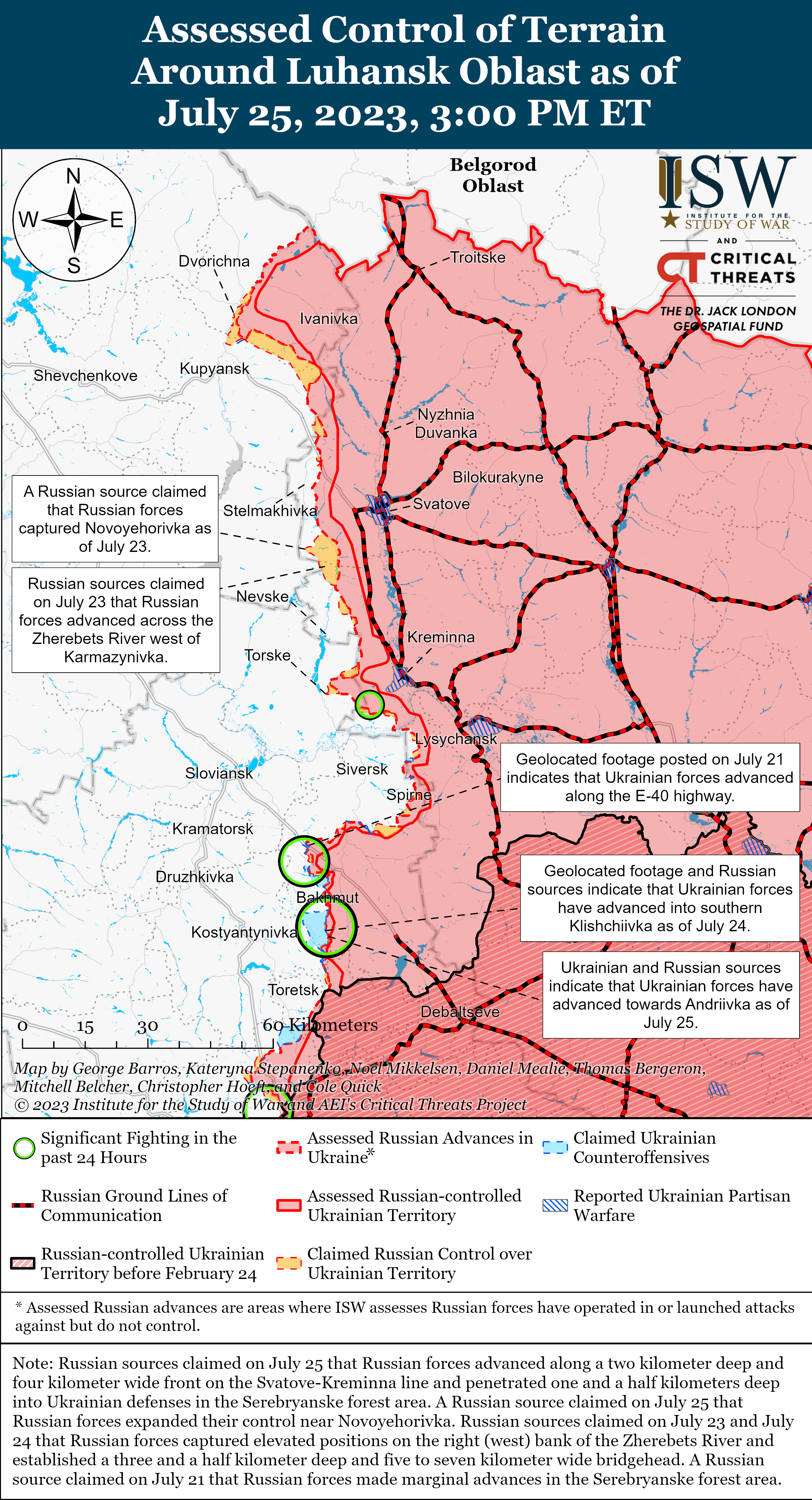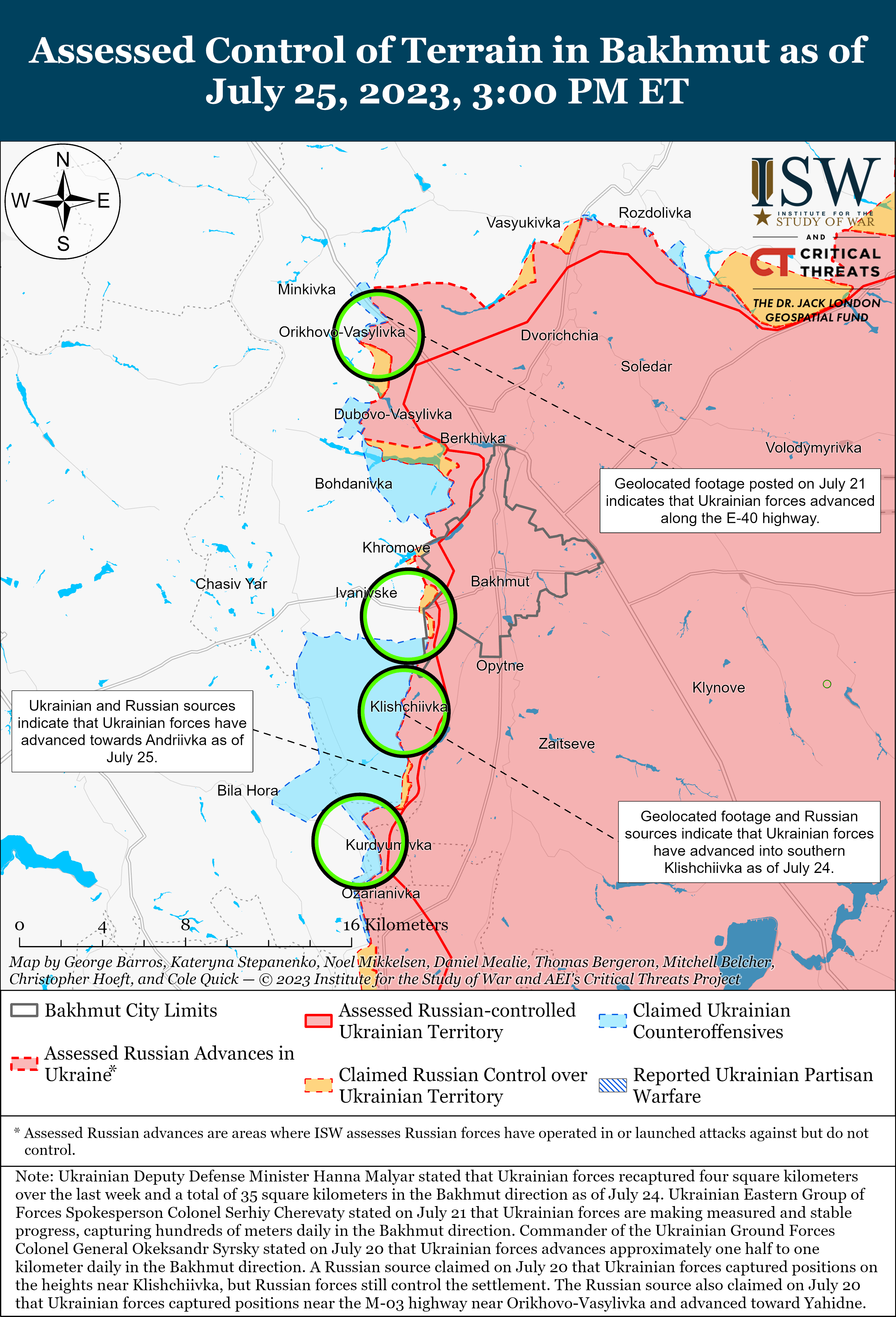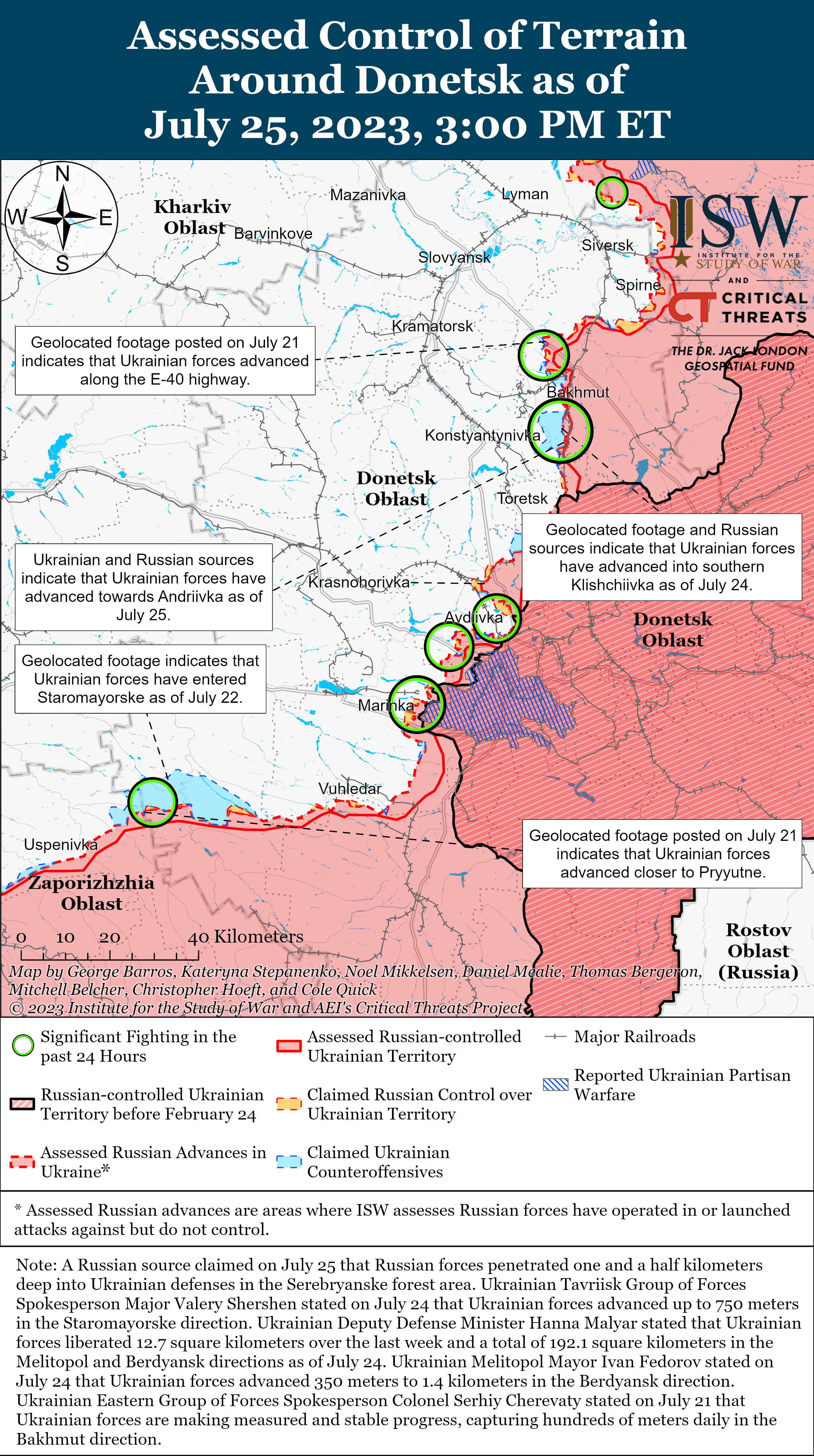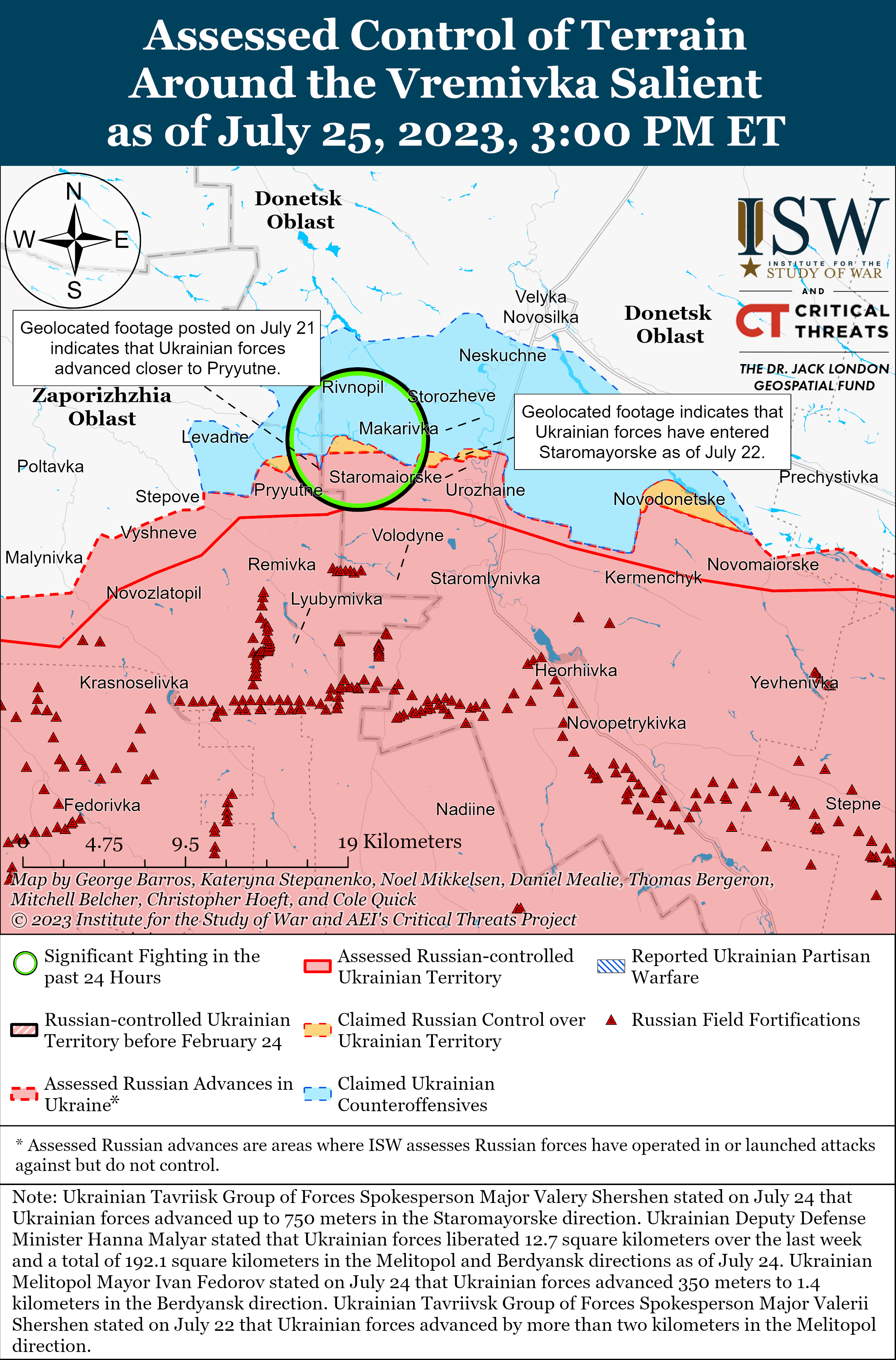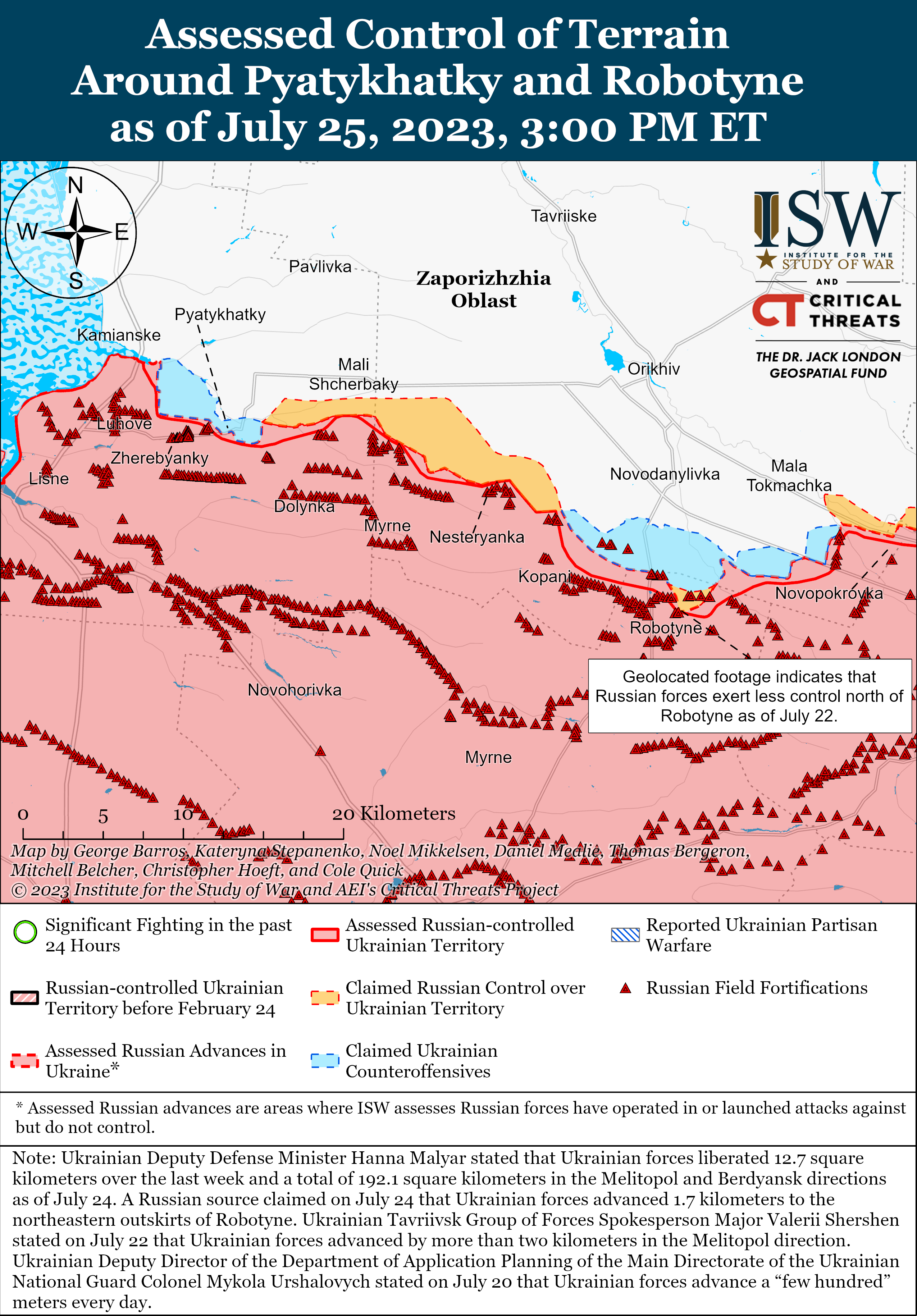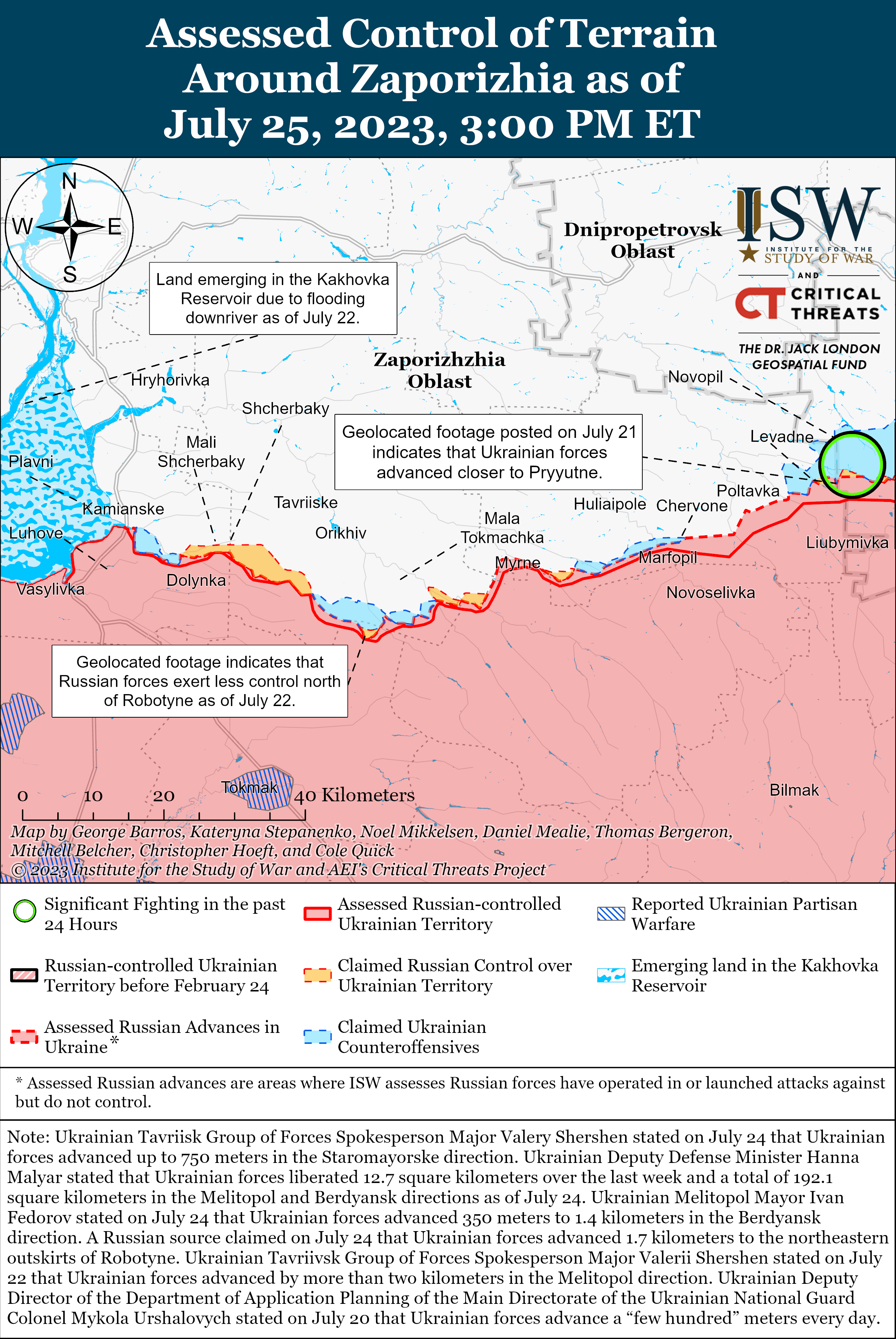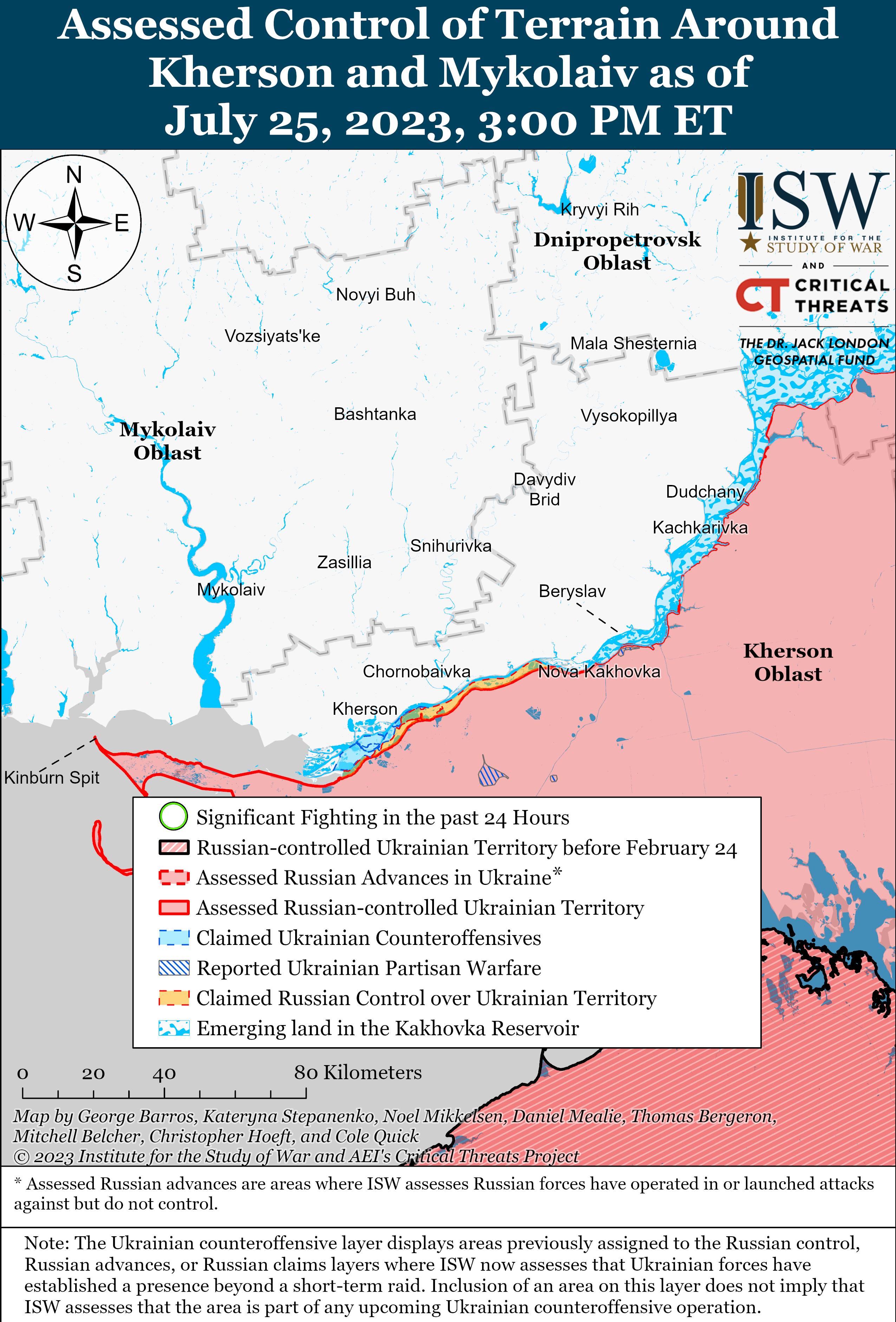 |
 |
Russian Offensive Campaign Assessment, July 25, 2023

Russian Offensive Campaign Assessment, July 25, 2023
Nicole Wolkov, Angelica Evans, Riley Bailey, Karolina Hird, Christina Harward, and Frederick W. Kagan
July 25, 2023, 7:20pm ET
Click here to see ISW’s interactive map of the Russian invasion of Ukraine. This map is updated daily alongside the static maps present in this report.
Click here to access ISW’s archive of interactive time-lapse maps of the Russian invasion of Ukraine. These maps complement the static control-of-terrain map that ISW produces daily by showing a dynamic frontline. ISW will update this time-lapse map archive monthly.
Note: The data cutoff for this product was 12:30pm ET on July 25. ISW will cover subsequent reports in the July 26 Russian Offensive Campaign Assessment.
Russian President Vladimir Putin continued to manifest concern over potential threats that the Wagner Group and its financier Yevgeny Prigozhin may pose during an impromptu two-day extension of Belarusian President Alexander Lukashenko’s visit to St. Petersburg. BBC’s Russian Service reported on July 25 that Putin told Lukashenko at the beginning of their July 23 meeting that Putin was ready to adjust his schedule to prolong Lukashenko’s visit and “discuss important topics in more detail.”[1] Kremlin Spokesperson Dmitry Peskov reported on July 25 that Putin and Lukashenko intended to “’synchronize watches’ and exchange views” but not sign any agreements during their prolonged meeting.[2] Peskov also reported that Putin and Lukashenko discussed the Wagner Group, the Union State, and external threats on the borders of Russia and Belarus.[3] Putin’s decision to prolong his meeting with Lukashenko likely shows Putin’s continued concerns about Wagner, which it appears that Lukashenko did not allay.
Lukashenko likely seeks to leverage his power over the Wagner Group to gain concessions from Putin. A Russian insider source claimed that the Wagner Group was the most important topic during the Putin-Lukashenko meeting, and that Lukashenko sought more economic assistance to Belarus through Union State programs.[4] The insider source also claimed that Putin wanted Belarus to be more involved in the war in Ukraine and rejected Lukashenko’s compromise offer to have Belarusian forces conduct a show of force on Belarus’ border with Ukraine.[5] Lukashenko was likely trying to leverage Putin’s concern over the Wagner Group throughout the entire visit to Russia to gain favorable conditions in Belarusian-Russian relations while deflecting Putin’s demands for closer integration into the Union State and support for Russia’s war in Ukraine.
Russian leadership is attempting to mitigate the security vacuum left by the Wagner Group’s departure by creating formalized but decentralized military “enterprises” on the basis of federal subjects (regions). The Russian State Duma adopted the second and third readings of amendments to the federal law regulating the circulation of weapons in constituent entities of the Russian Federation on July 25 that will allow heads of Russian federal subjects to create specialized state unitary enterprises.[6] Russian opposition media noted that certain intricacies in the amendments allow regional heads to create regionally based militarized state enterprises that are analogous to private military companies (PMCs) during a period of mobilization under martial law.[7] The amendments notably require regional and local budgets to finance the special enterprises, which will be equipped with small arms by the Russian Ministry of Defense (MoD) and will assist the Russian State Security Service (FSB), Ministry of Internal Affairs (MVD) and other military authorities in ensuring public order and border security.[8] The amendments would allow Russian President Vladimir Putin to create the enterprises on a temporary basis and later abolish them, after which these enterprises would have to transfer all small arms and other weapons back to the Russian MoD within a month.[9]
The Kremlin is likely trying to balance two competing security requirements—the need for combat capable formations that can fulfill roles left by the Wagner Group following their armed rebellion and relocation to Belarus and the desire not to recreate the systemic threats to the Russian state that Wagner’s independence posed. The creation of formal militarized state enterprises that will fulfill border security and domestic law enforcement tasks is likely intended in part to remedy the gap left by Wagner. However, the fact that these enterprises are so heavily decentralized and will operate under the auspices of internal security organs on the basis and expense of regional and local governments suggests that the Russian military leadership is very alive to the risk of recreating a powerful Wagner analogue and is therefore trying to limit the scale and power each individual enterprise can obtain. These state enterprises also appear to be a renewed iteration of the failed volunteer battalion model that Russian regions employed throughout the summer of 2022, but these enterprises will operate under formalized and consolidated domestic security organs such as the FSB, likely to mitigate many of the weaknesses in the old volunteer battalion system.
Ukrainian forces continued counteroffensive operations on at least three sectors of the front and advanced on July 25.[10] Geolocated footage published on July 25 shows that Ukrainian forces have made tactically significant gains south of Klishchiivka (7km southwest of Bakhmut).[11] The Ukrainian General Staff reported that Ukrainian forces conducted offensive operations in the Bakhmut, Melitopol (western Zaporizhia Oblast), and Berdyansk (Zaporizhia-Donetsk Oblast border area) directions.[12] Ukrainian sources reported that Ukrainian forces advanced up to 750 meters in the direction of Staromayorske (9km south of Velyka Novosilka), and Russian sources claimed Ukrainian forces made marginal advances west of Orikhiv.[13] Ukrainian Deputy Defense Minister Hanna Malyar reported that Russian forces are dying at a rate eight times higher than Ukrainian forces in the Bakhmut area and 5.3 times higher in the Berdyansk and Melitopol directions.[14] ISW has previously assessed that Ukrainian counteroffensive operations aim to create an asymmetrical attrition gradient that conserves Ukrainian manpower at the cost of a slower rate of territorial gains, while gradually wearing down Russian manpower and equipment.[15]
Russian forces conducted another series of Shahed drone strikes on rear areas of Ukraine overnight on July 24-25. Ukrainian Air Force Spokesperson Colonel Yuriy Ihnat reported on July 25 that Ukrainian forces recorded the launch of about 10 Shahed drones, five of which Ukrainian forces destroyed.[16] Ukrainian military sources reported drones over Kyiv City and Cherkasy, Sumy, Poltava, and Zhytomyr oblasts.[17] The Kyiv City Military Administration noted that this was the sixth drone strike on the capital city in July alone.[18] The Russian Ministry of Defense (MoD) and other Russian sources claimed that the strikes targeted Ukrainian concentration areas, Western-provided military equipment and other military infrastructure, but Ukrainian sources noted that many of the drones struck open fields and empty hangars.[19]
The Angry Patriots Club continues efforts to cast former Russian officer and ardent nationalist Igor Girkin (Strelkov) as an opposition figure and may be attempting to appeal to Russian President Vladimir Putin through rhetoric about the illegality of Girkin’s arrest. The Angry Patriots Club, known in the Russian information space for its virulent pro-war, ultranationalist rhetoric and willingness to criticize the Russian Ministry of Defense (MoD), the Kremlin, and even Putin himself, has unexpectedly postured itself as an organization concerned about the rule of law following Girkin’s arrest.[20] The organization is attempting to cast Girkin as an opposition figure in Russian politics by arguing that his arrest is unlawful and by launching the social media campaign “#FreedomtoStrelkov.”[21] The Angry Patriots Club may be employing rhetoric about the illegality of Girkin’s arrest as an appeal to Putin, who has historically (and ironically) portrayed himself as a defender of Russian democracy and has seemingly been hesitant to abandon the veil of legitimacy that Russia’s democratic institutions provide his authoritarian and corrupt rule.[22] The Angry Patriots Club may believe that the veneer of legality in Russia is personally important to Putin and that Putin might feel compelled to intervene if he believes Girkin’s arrest and detention is illegal. It is a further irony that Girkin’s statements seem straightforwardly to violate Russia’s repressive laws prohibiting criticism of the war and its leaders.[23] Russian opposition figures Alexei Navalny and Mikhail Khodorkovsky amplified the Angry Patriots Club’s framing of Girkin as a political prisoner and his arrest as illegal, though it is unclear how Navalny and Khodorkovsky intend for their support to affect Girkin’s detention and eventual sentencing.[24]
Putin and the Kremlin reportedly failed to respond promptly to the Wagner Group’s June 24 rebellion, leaving local Russian officials to make decisions concerning the group’s drive on Moscow. The Washington Post reported on July 25 that Ukrainian and European security officials stated that Putin did not issue orders for most of June 24 despite warnings from Russian security services about the likelihood of the rebellion at least two or three days beforehand.[25] Russian security services reportedly increased security at several strategic locations, including the Kremlin, in the days before the rebellion but took no other actions.[26] Regional Russian officials reportedly had to decide how to respond to the rebellion, and regional military and security officials were reportedly the ones that decided not to try to stop Wagner convoys by force.[27] The Kremlin’s and Putin’s alleged lack of response indicates that the Russian security apparatus had likely not prepared for a direct challenge to the Russian military leadership and likely did not have the capacity to quickly bring the rebellion to an end. The Kremlin is likely aware that its paralysis highlighted a degree of regime instability and appears to be consolidating Russia’s internal security apparatus in the Rosgvardia (Russian National Guard) to prepare for further internal threats and to signal resolve.[28] Putin’s failure to act quickly also suggests that he is uncertain about his ability to rally the Russian elite around him and may indicate how factional internal Kremlin politics have become. A senior NATO official reportedly stated that unspecified senior Russian political figures in Moscow appeared ready to rally behind Prigozhin in the event that Wagner’s rebellion succeeded.[29] The Kremlin is likely trying to identify Russian elites who may have been prepared to side with Prigozhin and likely views regional officials’ decisions not to stop Wagner's advance as an indicator of disloyalty. Tula Oblast Governor and former head of Russia’s Special Operations Forces Alexei Dyumin has likely drawn further suspicion due to his previous affiliations with Prigozhin and his role in the negotiations that ended the rebellion.[30]
Key Takeaways:
- Russian President Vladimir Putin continued to manifest concern over potential threats that the Wagner Group and its financier Yevgeny Prigozhin may pose during an impromptu two-day extension of Belarusian President Alexander Lukashenko’s visit to St. Petersburg. Lukashenko likely seeks to leverage his power over the Wagner Group to gain concessions from Putin.
- Russian leadership is attempting to mitigate the security vacuum left by the Wagner Group’s departure by creating formalized but decentralized military “enterprises” on the basis of federal subjects (regions).
- Ukrainian forces continued counteroffensive operations on at least three sectors of the front and advanced on July 25.
- Russian forces conducted another series of Shahed drone strikes on rear areas of Ukraine overnight on July 24-25.
- The Angry Patriots Club continues efforts to cast former Russian officer and ardent nationalist Igor Girkin (Strelkov) as an opposition figure and may be attempting to appeal to Russian President Vladimir Putin through rhetoric about the illegality of Girkin’s arrest.
- Putin and the Kremlin reportedly failed to respond promptly to the Wagner Group’s June 24 rebellion, leaving local Russian officials to make decisions concerning the group’s drive on Moscow.
- Russian forces conducted offensive operations near Svatove, Kreminna, the Bakhmut area, the Avdiivka-Donetsk City area, and the Zaporizhia-Donetsk Oblast border area and made claimed advances near Svatove, Kreminna, and Bakhmut.
- Ukrainian forces conducted offensive operations near Kreminna, the Bakhmut area, the Avdiivka-Donetsk City area, along the administrative border between Zaporizhia and Donetsk oblasts, and western Zaporizhia Oblast and advanced in the Bakhmut area, in some areas along the administrative border between Zaporizhia and Donetsk oblasts, and west of Orikhiv.
- US intelligence officials warned on July 25 that Russia’s drone supply will dramatically increase as a result of continued bilateral Russo-Iranian cooperation.
- Russian officials continue efforts to deconflict legal discrepancies as part of the incorporation of occupied territories.
We do not report in detail on Russian war crimes because these activities are well-covered in Western media and do not directly affect the military operations we are assessing and forecasting. We will continue to evaluate and report on the effects of these criminal activities on the Ukrainian military and the Ukrainian population and specifically on combat in Ukrainian urban areas. We utterly condemn these Russian violations of the laws of armed conflict, Geneva Conventions, and humanity even though we do not describe them in these reports.
- Russian Main Effort – Eastern Ukraine (comprised of two subordinate main efforts)
- Russian Subordinate Main Effort #1 – Capture the remainder of Luhansk Oblast and push westward into eastern Kharkiv Oblast and encircle northern Donetsk Oblast
- Russian Subordinate Main Effort #2 – Capture the entirety of Donetsk Oblast
- Russian Supporting Effort – Southern Axis
- Russian Mobilization and Force Generation Efforts
- Activities in Russian-occupied areas
Russian Main Effort – Eastern Ukraine
Russian Subordinate Main Effort #1 – Luhansk Oblast (Russian objective: Capture the remainder of Luhansk Oblast and push westward into eastern Kharkiv Oblast and northern Donetsk Oblast)
Russian forces conducted offensive operations near Svatove and made claimed advances on July 25. The Russian Ministry of Defense (MoD) claimed that elements of the 15th Motorized Rifle Brigade (2nd Combined Arms Army, Central Military District) captured Serhiivka (12km southwest of Svatove) and advanced along a front four kilometers wide to a depth of two kilometers in the area.[31] ISW has not observed visual confirmation of this claim, however. Russian sources claimed that Russian forces crossed the Zherebets River and attacked Ukrainian positions near Karmazynivka (12km southwest of Svatove).[32] A Russian milblogger claimed that Russian forces expanded their foothold near Novoyehorivka (15km southwest of Svatove).[33] Former Ukrainian Luhansk Oblast Head Serhiy Haidai reported on July 25 that Russian forces are attacking in groups of 50 to 70 personnel and are using “Storm-Z” units in the Kupyansk and Lyman directions.[34]
Russian forces conducted limited ground attacks near Kreminna and made claimed advances on July 25. The Russian MoD claimed that elements of the 234th Airborne Assault Regiment (76th Air Assault Division) repelled Ukrainian attacks in the Serebryanske forest area (10km southwest of Kreminna), counterattacked, and advanced 1.5 kilometers.[35] ISW has not observed visual evidence to confirm this claim. The Ukrainian General Staff reported that Russian forces conducted unsuccessful attacks south of Dibrova (7km southwest of Kreminna).[36] A Russian milblogger claimed that Russian forces unsuccessfully attacked near Torske (15km west of Kreminna).[37]
The Russian MoD claimed that Russian forces repelled Ukrainian attacks near Kreminna and did not make any advances on July 25. The Russian MoD claimed that Russian forces repelled Ukrainian attacks near Chervonopopivka (6km north of Kreminna), Nevske (18km northwest of Kreminna), Bilohorivka (10km south of Kreminna), Torske, and in the Serebryanske forest area.[38]
Recent Russian MoD claims of Russian advances along the Kupyansk-Svatove-Kreminna line may be exaggerated in order to draw attention away from Ukrainian counteroffensive efforts elsewhere along the front, as ISW has previously assessed.[39] Russian milbloggers are not widely amplifying or circulating the Russian MoD’s claims of Russian gains, which is a deviation from the typical information space cycle and suggests that the MoD claims are likely exaggerated for rhetorical effect. Ukrainian military sources have additionally not acknowledged any fighting in these areas over the past several days, even as they acknowledge Russian ground attacks elsewhere in the theater. ISW has not observed either visual confirmation or additional milblogger speculation of fighting or gains in these areas.
Russian Subordinate Main Effort #2 – Donetsk Oblast (Russian Objective: Capture the entirety of Donetsk Oblast, the claimed territory of Russia’s proxies in Donbas)
Ukrainian forces conducted offensive operations in the Bakhmut area and made tactically significant gains south of Bakhmut on July 25. Geolocated footage posted on July 25 shows that Ukrainian forces advanced south of Klishchiivka (7km southwest of Bakhmut).[40] A Kremlin-affiliated milblogger claimed that Ukrainian forces gained a position on the heights adjacent to Klishchiivka on July 24 and that there is heavy fighting on the outskirts of the settlement.[41] Several milbloggers also claimed that Ukrainian forces occupied a section of the heights near Klishchiivka and that Ukrainian forces entered the southern and southwestern outskirts of the settlement.[42] One Russian milblogger claimed that Ukrainian forces occupy 90 percent of the forest area along the western outskirts of Klishchiivka.[43] Several milbloggers claimed that neither Russian nor Ukrainian forces control the entire settlement, however.[44] The Ukrainian General Staff reported on July 25 that Ukrainian forces conducted offensive operations north and south of Bakhmut and that Russian forces withdrew from Andriivka (20km southwest of Bakhmut and directly south of Klishchiivka.[45] A Russian milblogger also claimed that Ukrainian forces broke through Russian defensive lines to Andriivka (10km southwest of Bakhmut), though other milbloggers claimed that Ukrainian forces have increased offensive operations but have not advanced to the settlement.[46]
Russian forces continued ground attacks in the Bakhmut area on July 25 and reportedly advanced north of Bakhmut. The Ukrainian General Staff also reported that Russian forces conducted unsuccessful offensive operations northwest of Orikhovo-Vasylivka (11km northwest of Bakhmut), south of Ivanivske (6km west of Bakhmut), east of Stupochky (12km southwest of Bakhmut), near Dyliivka (15km southwest of Bakhmut), and west of Klishchiivka.[47] The Russian Ministry of Defense (MoD) claimed that elements of the Russian Southern Grouping of Forces repelled Ukrainian attacks near Klishchiivka and Zaitseve (20km south of Bakhmut).[48] A Russian milblogger claimed that Russian forces regained control of the outskirts of Berkhivka (6km northwest of Bakhmut) and unspecified territory and positions in the forest area near Yahidne (2km north of Bakhmut).[49] Another milblogger claimed that Russian forces unsuccessfully counterattacked near Bohdanivka (6km northwest of Bakhmut), Orikhovo-Vasylivka, and Klishchiivka and did not advance.[50] Several milbloggers amplified footage claiming to show elements of the Russian 14th Territorial Defense Battalion ”Ghost” (4th Separate Motorized Rifle Brigade, Luhansk People’s Republic’s [LNR] 2nd Army Corps) operating near Klishchiivka.[51]
Russian sources reported that Ukrainian forces conducted ground attacks in the Avdiivka-Donetsk City area on July 25 and did not advance. The Russian MoD claimed that Ukrainian forces conducted unsuccessful offensive operations near Pervomaiske (11km southwest of Avdiivka) and Marinka (on the southwestern outskirts of Donetsk City).[52]
Russian forces conducted ground attacks in the Avdiivka-Donetsk City area on July 25 but did not advance. The Ukrainian General Staff reported that Russian forces conducted unsuccessful offensive operations near Avdiivka, Pervomaiske, Marinka, and Krasnohorivka (directly west of Donetsk City).[53] A Russian milblogger posted footage claiming to show elements of the Russian 1st Separate Motorized Rifle Brigade “Slavic” (Donetsk People’s Republic’s [DNR] 1st Army Corps) operating near Opytne (4km southwest of Avdiivka).[54]
Russian Supporting Effort – Southern Axis (Russian objective: Maintain frontline positions and secure rear areas against Ukrainian strikes)
Ukrainian forces continued counteroffensive operations along the administrative border between Zaporizhia and Donetsk oblasts on July 25 and reportedly made gains in some areas. The Ukrainian General Staff reported that Ukrainian forces continued offensive operations in the Berdyansk (Zaporizhia-Donetsk Oblast border area) direction and achieved success in the direction of Staromayorske (9km south of Velyka Novosilka).[55] Ukrainian Tavriisk Group of Forces Spokesperson Major Valerii Shershen stated that Ukrainian forces advanced up to 750m in the direction of Staromayorske.[56] The Russian Ministry of Defense (MoD) reported that Russian elements of the Eastern Grouping of Forces repelled four Ukrainian assaults near Staromayorske.[57] A Russian milblogger claimed that a small Ukrainian infantry group conducted an assault on the northern outskirts of Staromayorske.[58] Russian sources also claimed that Russian forces repelled Ukrainian assaults near Pryyutne (16km southwest of Velyka Novosilka) and Urozhaine (9km south of Velyka Novosilka).[59] Russian milbloggers amplified footage on July 25 showing elements of the Donetsk People‘s Republic (DNR) ”Kaskad” Operational Tactical Combat Formation operating near Novomayorske (18km southeast of Velyka Novosilka) and elements of the 14th Spetsnaz Brigade (Main Directorate of the General Staff [GRU]) operating in an unspecified location in western Donetsk Oblast.[60]
Russian forces conducted limited counterattacks in the Zaporizhia-Donetsk Oblast border area but did not advance on July 25. The Ukrainian General Staff reported that Russian forces conducted an unsuccessful ground attack in the direction of Rivnopil (11km southwest of Velyka Novosilka).[61] A Russian milblogger claimed that Russian forces also unsuccessfully counterattacked near Pryyutne.[62]
Ukrainian forces continued counteroffensive operations in western Zaporizhia Oblast and reportedly made marginal advances west of Orikhiv on July 25. The Ukrainian General Staff reported that Ukrainian forces continued offensives in the Melitopol (western Zaporizhia Oblast) direction.[63] Russian milbloggers claimed that Ukrainian forces conducted assaults from near Lobkove (26km southwest of Orikhiv) towards Luhove (31km southwest of Orikhiv) and noted that Ukrainian forces in the area usually conduct assaults from near Pyatykhatky (25km southwest of Orikhiv) towards Zherebyanky (26km southwest of Orikhiv).[64] Russian milbloggers claimed that Russian forces retreated to unspecified prepared lines of defense in the area.[65] Other Russian milbloggers claimed that Russian forces repelled Ukrainian assaults in the Pyatykhatky area and that Russian artillery units struck a small Ukrainian group with armored vehicles that tried to advance in the direction of Robotyne (12km south of Orikhiv).[66]
International Atomic Energy Agency (IAEA) General Director Raphael Grossi acknowledged on July 24 that Russian forces have laid additional mines on the periphery of the Zaporizhzhia Nuclear Power Plant (ZNPP).[67] Grossi stated that IAEA inspectors saw additional Russian mines in a buffer zone between the ZNPP’s internal and external perimeter barriers.[68] Grossi reiterated that the IAEA has been aware of the previous placement of mines outside of the ZNPP perimeter and at places within the ZNPP perimeter.[69]
A Russian milblogger claimed that Russian artillery units prevented a Ukrainian sabotage and reconnaissance group from landing near the Antonivsky Bridge on the east (left) bank of Kherson Oblast.[70]
A Russian milblogger claimed that Ukrainian forces conducted another strike on rear Russian targets in Crimea on July 25. The milblogger claimed that Ukrainian forces struck a Russian military equipment repair facility near Kremnivka (51km north of Simferopol) with three Storm Shadow cruise missiles, damaging three units of unspecified equipment.[71]
The Russian Ministry of Defense (MoD) claimed that Ukrainian forces attacked a Russian patrol ship with naval drones on the night of July 24 to 25. The MoD claimed that Russian forces destroyed two Ukrainian naval drones within a kilometer of the “Sergey Kotov” patrol ship of the Black Sea Fleet as it was conducting navigation control tasks 370km southwest of Sevastopol.[72]
Russian Mobilization and Force Generation Efforts (Russian objective: Expand combat power without conducting general mobilization)
US intelligence officials warned on July 25 that Russia’s drone supply will dramatically increase as a result of continued bilateral Russo-Iranian cooperation. Analysts from the US Defense Intelligence Agency (DIA) told reporters that after the completion of the Shahed drone manufacturing facility in the Republic of Tatarstan, Russia will likely have a stockpile of drones “orders of magnitude larger” than what Russia has been able to procure from Iran to date.[73]
The Russian military is allegedly continuing dangerous and illogical ammunition storage practices. A Kremlin-affiliated Russian milblogger claimed that Russian inspectors reprimanded Russian forces along the front line in southern Ukraine for placing ammunition stores at a distance from one another.[74] ISW has observed footage of the recent Ukrainian strikes on Russian ammunition depots in Crimea that suggests that the Russian military is concentrating ammunition stores at least in rear areas such that Ukrainian strikes trigger many secondary explosions over a long period of time. Sound practice dictates separating smaller ammunition stores from one another whenever possible. The allegation that select Russian commanders are countermanding local commanders’ sounder storage plans and reprimanding those commanders for trying to do the tactically appropriate thing speaks to several of the systemic command and control issues faced by Russian troops in southern Ukraine.
The Russian State Duma adopted numerous laws and amendments on July 25 related to Russia’s war effort. The State Duma adopted amendments that would raise the upper limit of the conscription age, meaning that Russian citizens aged 18-30 will be eligible for conscription starting in January 2024.[75] The head of the State Duma Defense Committee Andrey Kartapolov stated that the Russian legislature amended the law because ”the demographic situation is serious” and is affecting the number of citizens available for mobilization.[76] Kartapolov said that the amendments were written ”for a major war, for general mobilization,“ suggesting the amendments were not related to the ongoing so-called ”special military operation” but rather for a hypothetical future large-scale war.[77] The Duma also adopted a law that would simplify the public procurement procedures of the Russian Ministry of Defense (MoD) and is aimed at expediting the process of supplying military formations operating in Ukraine.[78] The Duma additionally approved amendments that will allow citizens to be detained for 30 days under martial law rather than the current 48 hours.[79] The Duma is also considering amendments that would prohibit Russian citizens from leaving the country as soon as authorities enter their summonses into the electronic register.[80]
Activities in Russian-occupied areas (Russian objective: Consolidate administrative control of annexed areas; forcibly integrate Ukrainian civilians into Russian sociocultural, economic, military, and governance systems)
Russian officials continue efforts to deconflict legal discrepancies as part of the incorporation of occupied territories. The Southern Military District (SMD) military court began hearing criminal cases for 18 members of the Ukrainian “Aidar” battalion on July 25.[81] Russian state newswire TASS reported that Russian occupation officials initially started proceedings under Donetsk People’s Republic (DNR) criminal code but that Russian officials have reclassified the case under the Russian criminal code.[82] Russian authorities recently transferred sham trials for 22 ”Azov militants” from occupied Mariupol to Rostov-on-Don, Rostov Oblast, reportedly due to bureaucratic challenges resulting from discrepancies between DNR and Russian legal statutes.[83]
Ukrainian sources confirmed that additional Russian government organs are involved in the relocation of Ukrainian children from occupied territories to Russia. The Ukrainian Resistance Center reported on July 25 that the Russian Ministry of Nature organized vacations for 77 children from occupied Zaporizhia Oblast to Stavropol Krai in coordination with administrators at the Stavropol State Pedagogical Insitute.[84]
Significant activity in Belarus (Russian efforts to increase its military presence in Belarus and further integrate Belarus into Russian-favorable frameworks and Wagner Group activity in Belarus).
A Wagner-affiliated source claimed that remaining Wagner forces will leave occupied Luhansk Oblast by August 1 due to the Russian Ministry of Defense (MoD) requiring that all Wagner personnel leave the “special operation” zone by August 1.[85] Wagner Group financier Yevgeny Prigozhin claimed in June prior to the rebellion that Wagner forces would return to fight in Ukraine on August 5 following two months of training and rest.[86] It is unlikely that Wagner forces will rejoin hostilities in Ukraine in the foreseeable future because they lack the requisite heavy weaponry. The Russian MoD reported that Wagner forces planned to relinquish all heavy weaponry on June 27, geolocated footage of Wagner convoys moving to Belarus does not show them transporting heavy weaponry to new training grounds, and satellite images of Wagner camps in Belarus do not show heavy weaponry in or near the camps.[87] Wagner Group fighters may have the combat capability to fight in Ukraine in small infantry groups armed with basic small arms, but this is unlikely if the Russian MoD ordered that all Wagner forces leave occupied Luhansk Oblast by August 1. ISW continues to assess that Wagner forces in Belarus currently pose no significant threat to Ukraine or to NATO.[88]
Wagner forces continue to train Belarusian forces. Geolocated footage published on July 24 shows Wagner personnel training Belarusian forces at a training ground near Brest, Brest Oblast.[89] Photos published on July 24 purportedly show Wagner commanders with the Belarusian Special Rapid Response (SOBR) commander, Minsk Special Police (OMON) commander, the Deputy Minister of Internal Affairs who is also 3rd Separate Red Banner Spetsnaz Brigade (also known as Military Unit 3214) commander, and the “Almaz” Special Anti-Terrorism Unit commander, after joint training at an unspecified location in Belarus.[90] Photos published on July 25 purportedly show joint training between Wagner forces and the Belarusian 51st Artillery Brigade near Asipovichy, Mogilev Oblast.[91] The Belarusian Ministry of Defense (MoD) claimed that Wagner instructors are conducting joint exercises with various Belarusian forces including special operations, mechanized, engineering, radiation, chemical, and biological protection, and communications units.[92]
ISW will continue to report daily observed Russian and Belarusian military activity in Belarus, as part of ongoing Kremlin efforts to increase their control over Belarus and other Russian actions in Belarus.
Note: ISW does not receive any classified material from any source, uses only publicly available information, and draws extensively on Russian, Ukrainian, and Western reporting and social media as well as commercially available satellite imagery and other geospatial data as the basis for these reports. References to all sources used are provided in the endnotes of each update.
[1] https://t.me/bbcrussian/49966
[2] https://tass dot ru/politika/18355825
[3] https://tass dot ru/politika/18355825
[4] https://t.me/rusbrief/139604
[5] https://t.me/rusbrief/139604
[6] https://meduza dot io/news/2023/07/25/glavam-rossiyskih-regionov-razreshili-sozdavat-voenizirovannye-kompanii; https://sozd.duma.gov dot ru/bill/312507-8; https://t.me/svobodnieslova/2539
[7] https://t.me/sotaproject/63502; https://t.me/bbcrussian/49963; https://t.me/svobodnieslova/2535; https://meduza dot io/news/2023/07/25/glavam-rossiyskih-regionov-razreshili-sozdavat-voenizirovannye-kompanii
[8] https://t.me/sotaproject/63502; https://t.me/bbcrussian/49963; https://t.me/svobodnieslova/2535; https://meduza dot io/news/2023/07/25/glavam-rossiyskih-regionov-razreshili-sozdavat-voenizirovannye-kompanii
[9] https://t.me/sotaproject/63502; https://t.me/bbcrussian/49963; https://t.me/svobodnieslova/2535; https://meduza dot io/news/2023/07/25/glavam-rossiyskih-regionov-razreshili-sozdavat-voenizirovannye-kompanii
[11] https://twitter.com/VigorousFalcon/status/1683814317072973824?s=20 ; https://t.me/VDV_vistrel/267 ; https://twitter.com/GirkinGirkin/status/1683828702554071042?s=20
[12] https://www.facebook.com/GeneralStaff.ua/posts/pfbid02yvPmZRPfyobDGKLc8aTPovt1JRoeCWHvJTw48SrbWcuJmKHymku4df1Fr4EkKGBol
[13]https://www.facebook.com/GeneralStaff.ua/posts/pfbid02yvPmZRPfyobDGKLc8aTPovt1JRoeCWHvJTw48SrbWcuJmKHymku4df1Fr4EkKGBol ; https://suspilne dot media/535801-rf-obstrilala-kostantinivku-kasetnimi-boepripasami-u-ssa-zaavili-pro-uspihi-kontrnastupu-517-den-vijni-onlajn/?anchor=live_1690283715&utm_source=copylink&utm_medium=ps ; https://t.me/wargonzo/13975
[15] https://www.understandingwar.org/backgrounder/russian-offensive-campaign-assessment-july-4-2023%C2%A0;%C2%A0 ; https://www.understandingwar.org/backgrounder/russian-offensive-campaign-assessment-july-15-2023
[16] https://armyinform.com dot ua/2023/07/25/vorog-zastosovuye-protykorabelni-rakety-oniks-po-pryberezhnij-zoni-mykolayivshhyny-ta-odeshhyny-yurij-ignat/
[17] https://t.me/zhytomyrskaODA/4584; https://t.me/Sumy_news_ODA/18082; https://t.me/cherkaskaODA/5472; https://t.me/DMYTROLUNIN/9260; https://t.me/VA_Kyiv/2551
[18] https://t.me/VA_Kyiv/2551
[19] https://t.me/cherkaskaODA/5472; https://t.me/istories_media/3137; https://t.me/vrogov/11154 ; https://t.me/mod_russia/28608
[20] https://www.understandingwar.org/backgrounder/russian-offensive-campaign-assessment-june-25-2023 ; https://www.understandingwar.org/backgrounder/russian-offensive-campaign-assessment-april-8-2023 ; https://www.understandingwar.org/backgrounder/russian-offensive-campaign-assessment-may-21-2023 ; https://www.understandingwar.org/backgrounder/russian-offensive-campaign-assessment-may-14-2023
[22] https://www.vesti dot ru/article/1297371 ; http://rosnation dot ru/?page_id=523
[23] https://www.understandingwar.org/backgrounder/russian-offensive-campaign-assessment-february-25-2023
[24] https://t.me/navalny/3474 ; https://meduza dot io/news/2023/07/25/navalnyy-nazval-strelkova-politicheskim-zaklyuchennym ; https://t.me/khodorkovski/8428; https://meduza dot io/news/2023/07/25/hodorkovskiy-zayavil-vsled-za-navalnym-chto-strelkova-presleduyut-v-rossii-po-politicheskim-motivam
[25] https://www.washingtonpost.com/world/2023/07/25/putin-prigozhin-rebellion-kremlin-disarray/
[26] https://www.washingtonpost.com/world/2023/07/25/putin-prigozhin-rebellion-kremlin-disarray/
[27] https://www.washingtonpost.com/world/2023/07/25/putin-prigozhin-rebellion-kremlin-disarray/
[28] https://isw.pub/UkrWar071723
[29] https://www.washingtonpost.com/world/2023/07/25/putin-prigozhin-rebellion-kremlin-disarray/
[30] https://www.understandingwar.org/backgrounder/russian-offensive-campaign-assessment-june-26-2023 ; https://t.me/svobodnieslova/2292 ; https://t.me/Kalyyugatoday/126784 ; https://t.me/z_arhiv/22728 ; https://kirov-portal dot ru/news/vopros-otvet/kto-takoj-dyumin-kotoryj-mozhet-zanyat-post-ministra-oborony-vmesto-shojgu-29547/; https://news.obozrevatel dot com/russia/v-rossii-uzhe-nashli-novogo-ministra-oboronyi-dlya-prigozhina-v-seti-nazvali-imya.htm ; https://t.me/rybar/48996
[32] https://t.me/dva_majors/22087; https://t.me/readovkanews/63117
[33] https://t.me/wargonzo/13975
[34] https://t.me/serhiy_hayday/10041
[35] https://t.me/mod_russia/28607
[36] https://www.facebook.com/GeneralStaff.ua/posts/pfbid02oTx4HEzGamF4UZiVTiXDZzTS1UV1fS2aNpEcJUjpz3PsrsD2dEun2HbyBxXMv7Afl
[37] https://t.me/wargonzo/13975
[39] https://www.understandingwar.org/backgrounder/russian-offensive-campaign-assessment-july-21-2023; https://www.understandingwar.org/backgrounder/russian-offensive-campaign-assessment-july-18-2023
[40] https://twitter.com/VigorousFalcon/status/1683814317072973824?s=20 ; https://t.me/VDV_vistrel/267 ; https://twitter.com/GirkinGirkin/status/1683828702554071042?s=20
[42] https://t.me/grey_zone/19672 ; https://t.me/multi_XAM/561 ; https://t.me/sashakots/41199 ; https://t.me/milinfolive/104112 ; https://t.me/z_arhiv/23600
[45] https://www.facebook.com/GeneralStaff.ua/posts/pfbid02yvPmZRPfyobDGKLc8aTPovt1JRoeCWHvJTw48SrbWcuJmKHymku4df1Fr4EkKGBol; https://t.me/militarymediacenter/2640
[47] https://www.facebook.com/GeneralStaff.ua/posts/pfbid02oTx4HEzGamF4UZiVTiXDZzTS1UV1fS2aNpEcJUjpz3PsrsD2dEun2HbyBxXMv7Afl ; https://www.facebook.com/GeneralStaff.ua/posts/pfbid02U8UGpoyXKRDB9XaBEGoBH9Vi6DwFVcEMHERrNNRFUhmtsM6ZWo66B8tVvpckRbsQl; https://t.me/militarymediacenter/2640
[53] https://www.facebook.com/GeneralStaff.ua/posts/pfbid02oTx4HEzGamF4UZiVTiXDZzTS1UV1fS2aNpEcJUjpz3PsrsD2dEun2HbyBxXMv7Afl ; https://www.facebook.com/GeneralStaff.ua/posts/pfbid02U8UGpoyXKRDB9XaBEGoBH9Vi6DwFVcEMHERrNNRFUhmtsM6ZWo66B8tVvpckRbsQl ; https://www.facebook.com/GeneralStaff.ua/posts/pfbid02oTx4HEzGamF4UZiVTiXDZzTS1UV1fS2aNpEcJUjpz3PsrsD2dEun2HbyBxXMv7Afl ; https://www.facebook.com/GeneralStaff.ua/posts/pfbid02U8UGpoyXKRDB9XaBEGoBH9Vi6DwFVcEMHERrNNRFUhmtsM6ZWo66B8tVvpckRbsQl
[55] https://www.facebook.com/GeneralStaff.ua/posts/pfbid02yvPmZRPfyobDGKLc8aTPovt1JRoeCWHvJTw48SrbWcuJmKHymku4df1Fr4EkKGBol
[56] https://suspilne dot media/535801-rf-obstrilala-kostantinivku-kasetnimi-boepripasami-u-ssa-zaavili-pro-uspihi-kontrnastupu-517-den-vijni-onlajn/?anchor=live_1690283715&utm_source=copylink&utm_medium=ps
[61] https://www.facebook.com/GeneralStaff.ua/posts/pfbid02U8UGpoyXKRDB9XaBEGoBH9Vi6DwFVcEMHERrNNRFUhmtsM6ZWo66B8tVvpckRbsQl
[63] https://www.facebook.com/GeneralStaff.ua/posts/pfbid02oTx4HEzGamF4UZiVTiXDZzTS1UV1fS2aNpEcJUjpz3PsrsD2dEun2HbyBxXMv7Afl ; https://www.facebook.com/GeneralStaff.ua/posts/pfbid02U8UGpoyXKRDB9XaBEGoBH9Vi6DwFVcEMHERrNNRFUhmtsM6ZWo66B8tVvpckRbsQl
[66] https://t.me/frontbird/2654; https://t.me/dva_majors/22121 ; https://t.me/rusich_army/10087 ; https://t.me/rusich_army/10092
[67] https://www.iaea.org/newscenter/pressreleases/update-175-iaea-director-general-statement-on-situation-in-ukraine
[68] https://www.iaea.org/newscenter/pressreleases/update-175-iaea-director-general-statement-on-situation-in-ukraine
[69] https://www.iaea.org/newscenter/pressreleases/update-175-iaea-director-general-statement-on-situation-in-ukraine
[72] https://t.me/mod_russia/28599
[73] https://www.understandingwar.org/backgrounder/russian-offensive-campaign-assessment-june-9-2023 ; https://www.cnn.com/2023/07/25/politics/us-russia-iran-drones
[81] https://t.me/tass_agency/202458
[82] https://t.me/tass_agency/202458
[83] https://www.understandingwar.org/backgrounder/russian-offensive-campaign-assessment-june-28-2023
[84] https://sprotyv.mod dot gov.ua/minpryrody-rf-organizovuye-vyvezennya-ukrayinskyh-ditej-z-tot/
[85] https://t.me/prigozhin_2023_tg/2466; https://t.me/grey_zone/19666
[86] https://www.reuters.com/article/factcheck-prigozhin-return-video/fact-check-video-of-russias-prigozhin-announcing-wagners-return-to-frontlines-predates-mutiny-idUSL1N38Y2JF
[87] https://www.understandingwar.org/backgrounder/russian-offensive-campaign-assessment-june-27-2023; https://understandingwar.org/backgrounder/russian-offensive-campaign-assessment-july-23-2023; https://www.understandingwar.org/backgrounder/russian-offensive-campaign-assessment-july-16-2023
[88] https://understandingwar.org/backgrounder/russian-offensive-campaign-assessment-july-24-2023; https://www.understandingwar.org/backgrounder/russian-offensive-campaign-assessment-july-23-2023
[89] https://t.me/wagnernew/9020 ; https://twitter.com/osintseter/status/1683813057355567109?s=20
[90] https://t.me/belarusian_silovik/18874 ; https://t.me/NeoficialniyBeZsonoV/27882
[91] https://t.me/nevolf/25516; https://t.me/NeoficialniyBeZsonoV/27910
[92] https://t.me/modmilby/30089
